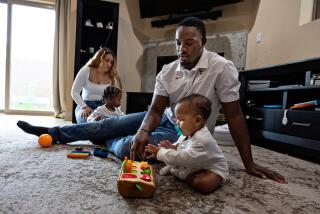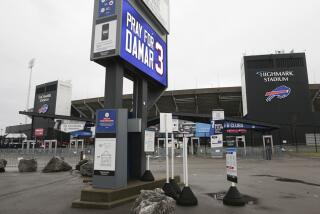Indications Byrd Injury May Not Be Permanent : Pro football: Positive signs give doctors cautious optimism that paralyzed Jet lineman might recover.
- Share via
NEW YORK — There is hope for Dennis Byrd.
The day after the New York Jets’ defensive lineman was carried off the field with a broken neck, his doctors would not rule out the possibility that he might walk again.
“We’re looking at this with guarded optimism,” Dr. Martin Cammins, a neurosurgeon, said Monday during a news conference on Byrd’s condition at Lenox Hill Hospital.
The 6-foot-5, 266-pound Byrd fractured his C-5 vertebra Sunday in a headfirst collision with teammate Scott Mersereau. His legs and lower arms remain paralyzed, and officially his prognosis is unknown.
“There’s no way at this point to predict his degree of recovery,” team physician Elliot Hershman said. “It can change day to day.”
But Hershman and a team of neurosurgeons and other spinal experts at the hospital did point to some developments that suggest the 26-year-old might recover.
For one, Byrd has some feeling in his legs and has demonstrated slight movement in his toes and fingers, the doctors said. Also, a battery of tests showed that while there is some bone and spinal cord damage, there is no constant pressure on the cord--another positive sign.
Byrd also is benefiting from recent advancements in the treatment of spinal injuries--including special steroids that help reduce swelling in the spine. Byrd was injected with “massive doses” of the drug shortly after the injury, Hershman said.
The doctors have fitted Byrd with a “halo vest,” consisting of a metal band that attaches to the head and is steadied by four metal rods projecting from a plastic vest. The vest is keeping Byrd’s spinal column stable.
Dr. Patrick O’Leary, an orthopedic surgeon who is heading the team of physicians treating Byrd, tentatively plans to operate on his neck on Wednesday. He said he will use metal plates and bone grafts to stabilize the vertebra.
Hershman said doctors should know more about Byrd’s prognosis one to two weeks after the surgery. That’s when a lengthy rehabilitation will begin.
While refusing to make any predictions, the doctors said they have seen patients with similar injuries walk again.
All agree that perhaps Byrd’s best ally is his attitude.
“He has a wonderful spirit,” O’Leary said.
Byrd’s wife is by his side and his parents were on the way, Hershman said. Jet coaches and players also are making steady visits.
More to Read
Go beyond the scoreboard
Get the latest on L.A.'s teams in the daily Sports Report newsletter.
You may occasionally receive promotional content from the Los Angeles Times.










